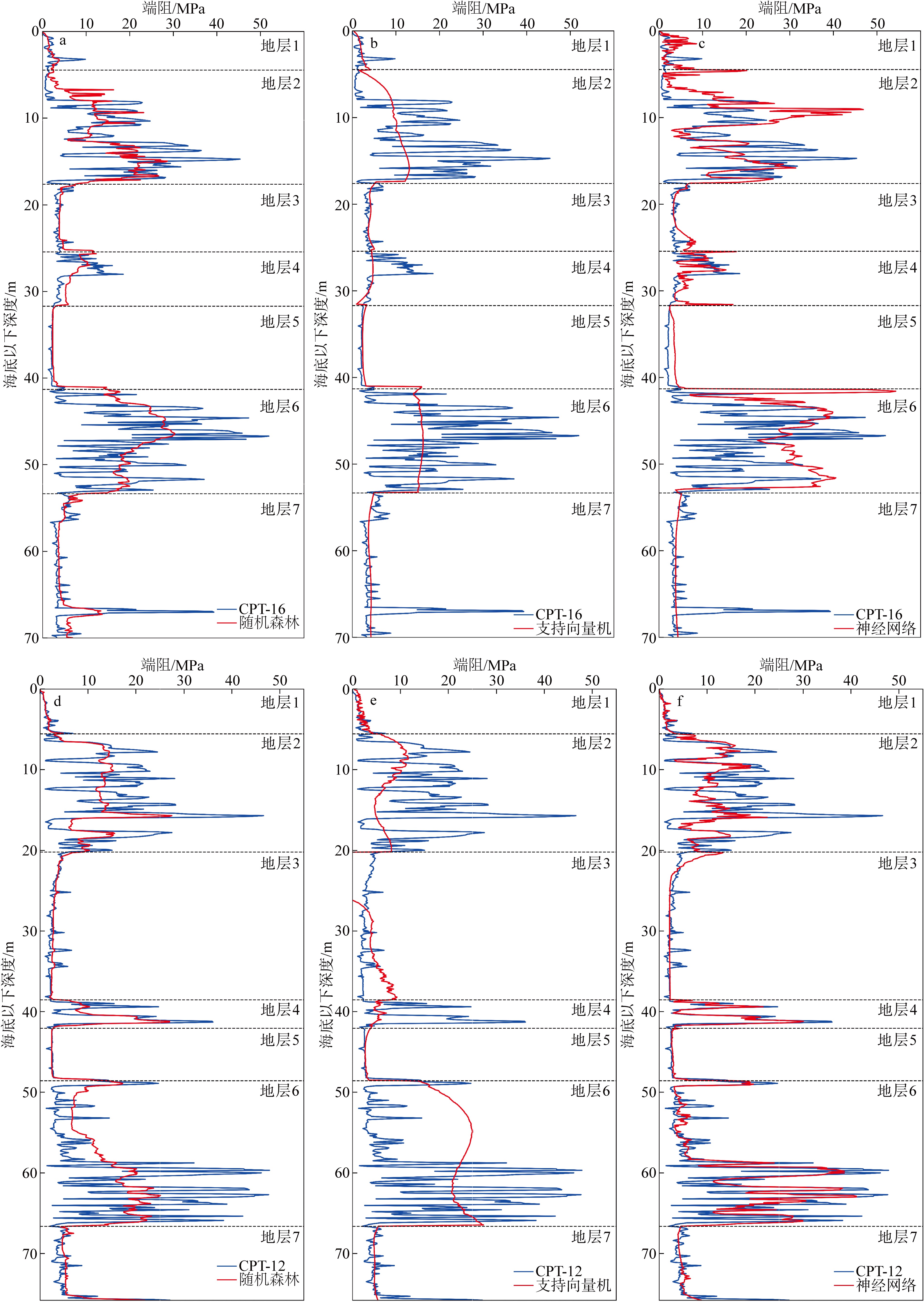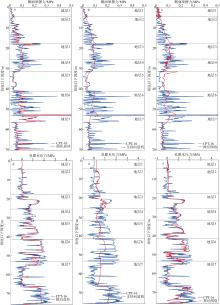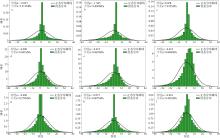| [1] |
蔡国军, 刘松玉, 童立元, 等, 2007. 多功能孔压静力触探(CPTU)试验研究[J]. 工程勘察, 35(3): 10-15, 73.
|
|
CAI GUOJUN, LIU SONGYU, TONG LIYUAN, et al, 2007. Research on the versatile piezocone penetration test (CPTU)[J]. Geotechnical Investigation & Surveying, 35(3): 10-15, 73 (in Chinese with English abstract).
|
| [2] |
董济涵, 王长虹, 2023. 压缩模量融合CPT数据的贝叶斯空间插值方法[J]. 上海大学学报(自然科学版), 29(1): 140-154.
doi: 10.12066/j.issn.1007-2861.2272
|
|
DONG JIHAN, WANG CHANGHONG, 2023. Bayesian spatial interpolation method for compression modulus fusion of CPT data[J]. Journal of Shanghai University (Natural Science Edition), 29(1): 140-154 (in Chinese with English abstract).
|
| [3] |
郭根发, 2022. 海床式静力触探在海上风电项目勘察中的应用[J]. 吉林水利, (12): 8-13, 17.
|
|
GUO GENFA, 2022. Application of seabed static penetration in the investigation of offshore wind power projects[J]. Jilin Water Resources, (12): 8-13, 17 (in Chinese with English abstract).
|
| [4] |
胡博锐, 刘宏扬, 蔡春麟, 等, 2022. 海洋工程地震在海上风电场工程地质勘察中的应用[J]. 海洋地质前沿, 38(9): 97-100.
|
|
HU BORUI, LIU HONGYANG, CAI CHUNLIN, et al, 2022. Application of marine engineering seismic in engineering geological investigation of offshore wind power[J]. Marine Geology Frontiers, 38(9): 97-100 (in Chinese with English abstract).
|
| [5] |
蒋水华, 冯泽文, 刘贤, 等, 2020. 基于自适应贝叶斯更新方法的岩土参数概率分布推断[J]. 岩土力学, 41(1): 325-335.
|
|
JIANG SHUIHUA, FENG ZEWEN, LIU XIAN, et al, 2020. Inference of probability distributions of geotechnical parameters using adaptive Bayesian updating approach[J]. Rock and Soil Mechanics, 41(1): 325-335 (in Chinese with English abstract).
|
| [6] |
姜贞强, 郇彩云, 王胜利, 等, 2020. 海上风电单桩基础动力特性识别及现场测试[J]. 太阳能学报, 41(7): 321-326.
|
|
JIANG ZHENQIANG, HUAN CAIYUN, WANG SHENGLI, et al, 2020. Dynamic characteristics identification of monopile offshore wind turbine and field tests[J]. Acta Energiae Solaris Sinica, 41(7): 321-326.
|
| [7] |
李新, 程国栋, 卢玲, 2000. 空间内插方法比较[J]. 地球科学进展, 15(3): 260-265.
|
|
LI XIN, CHENG GUODONG, LU LING, 2000. Comparison of spatial interpolation methods[J]. Advance in Earth Sciences, 15(3): 260-265 (in Chinese with English abstract).
|
| [8] |
李铮, 郭小江, 申旭辉, 等, 2022. 我国海上风电发展关键技术综述[J]. 发电技术, 43(2): 186-197.
doi: 10.12096/j.2096-4528.pgt.22028
|
|
LI ZHENG, GUO XIAOJIANG, SHEN XUHUI, et al, 2022. Summary of technologies for the development of offshore wind power industry in China[J]. Power Generation Technology, 43(2): 186-197 (in Chinese with English abstract).
doi: 10.12096/j.2096-4528.pgt.22028
|
| [9] |
梁文成, 林吉兆, 杜宇, 2013. 海床式静力触探设备在海上工程勘察中的应用[J]. 水运工程, (7): 19-21.
|
|
LIANG WENCHENG, LIN JIZHAO, DU YU, 2013. Application of seabed CPTU equipment in offshore investigation[J]. Port & Waterway Engineering, (7): 19-21 (in Chinese with English abstract).
|
| [10] |
刘吉臻, 马利飞, 王庆华, 等, 2021. 海上风电支撑我国能源转型发展的思考[J]. 中国工程科学, 23(1): 149-159.
doi: 10.15302/J-SSCAE-2021.01.021
|
|
LIU JIZHEN, MA LIFEI, WANG QINGHUA, et al, 2021. Offshore wind power supports China’s energy transition[J]. Strategic Study of CAE, 23(1): 149-159 (in Chinese with English abstract).
doi: 10.15302/J-SSCAE-2021.01.021
|
| [11] |
刘乐军, 李培英, 杜军, 等, 2004. 莺歌海油气资源开发区工程地质和灾害地质特征[J]. 海洋科学进展, 22(4): 455-464.
|
|
LIU LEJUN, LI PEIYING, DU JUN, et al, 2004. Characteristics of marine engineering geology and hazardous geology in the Yinggehai oil and gas resource development area[J]. Advances in Marine Science, 22(4): 455-464 (in Chinese with English abstract).
|
| [12] |
刘彦华, 杨晓军, 袁超, 等, 2019. 海洋物探方法在海上风电场勘察中的应用[J]. 地质学刊, 43(4): 619-626.
|
|
LIU YANHUA, YANG XIAOJUN, YUAN CHAO, et al, 2019. Application of marine geophysical exploration method in offshore wind farm survey[J]. Journal of Geology, 43(4): 619-626 (in Chinese with English abstract).
|
| [13] |
孟祥梅, 阚光明, 李官保, 等, 2015. 南黄海中西部海底空间沉积特征及工程地质特性[J]. 工程地质学报, 23(6): 1202-1210.
|
|
MENG XIANGMEI, KAN GUANGMING, LI GUANBAO, et al, 2015. Spatial characteristics and geotechnical properties of seafloor sediment in west-central area of southern Yellow Sea[J]. Journal of Engineering Geology, 23(6): 1202-1210 (in Chinese with English abstract).
|
| [14] |
牛海峰, 李向辉, 梁峰, 等, 2023. 面向海上风电开发建设的工程地质模型及应用研究[J]. 南方能源建设, 10(4): 57-70.
|
|
NIU HAIFENG, LI XIANGHUI, LIANG FENG, et al, 2023. Research on the engineering geological model and its application for offshore wind power development and construction[J]. Southern Energy Construction, 10(4): 57-70 (in Chinese with English abstract).
|
| [15] |
宋伟业, 刘灵玥, 阎洁, 等, 2023. 基于深度强化学习的海上风电集群自进化功率平滑控制方法[J]. 中国电力, 56(3): 36-46.
|
|
SONG WEIYE, LIU LINGYUE, YAN JIE, et al, 2023. Self-evolving power smooth control method for offshore wind power cluster based on deep reinforcement learning[J]. Electric Power, 56(3): 36-46 (in Chinese with English abstract).
|
| [16] |
唐丙寅, 吴冲龙, 李新川, 等, 2015. 一种基于钻孔地质数据的快速递进三维地质建模方法[J]. 岩土力学, 36(12): 3633-3638.
|
|
TANG BINGYIN, WU CHONGLONG, LI XINCHUAN, et al, 2015. A fast progressive 3D geological modeling method based on borehole data[J]. Rock and Soil Mechanics, 36(12): 3633-3638 (in Chinese with English abstract).
|
| [17] |
田密, 李典庆, 曹子君, 等, 2017. 基于贝叶斯理论的土性参数空间变异性量化方法[J]. 岩土力学, 38(11): 3355-3362.
|
|
TIAN MI, LI DIANQING, CAO ZIJUN, et al, 2017. Quantification of spatial variability of soil parameters using Bayesian approaches[J]. Rock and Soil Mechanics, 38(11): 3355-3362 (in Chinese with English abstract).
|
| [18] |
王博斐, 肖浩哲, 李国豪, 等, 2023. 基于控制目标的氢-电混动系统能量管理策略综述[J]. 发电技术, 44(4): 452-464.
doi: 10.12096/j.2096-4528.pgt.23003
|
|
WANG BOFEI, XIAO HAOZHE, LI GUOHAO, et al, 2023. A review of energy management strategy for hydrogen-electricity hybrid power system based on control target[J]. Power Generation Technology, 44(4): 452-464 (in Chinese with English abstract).
doi: 10.12096/j.2096-4528.pgt.23003
|
| [19] |
王长虹, 黄梦露, 2018. 岩土参数转换模型的贝叶斯校准方法[J]. 自然灾害学报, 27(4): 96-102.
|
|
WANG CHANGHONG, HUANG MENGLU, 2018. Transformation model for geotechnical parameters calibration based on Bayesian approach[J]. Journal of Natural Disasters, 27(4): 96-102 (in Chinese with English abstract).
|
| [20] |
薛明军, 陈福锋, 杨林刚, 等, 2023. 海上风电交流送出线路继电保护优化设计[J]. 电力系统保护与控制, 51(20): 150-159.
|
|
XUE MINGJUN, CHEN FUFENG, YANG LINGANG, et al, 2023. Optimized design of relay protection for an offshore wind power outgoing transmission line[J]. Power System Protection and Control, 51(20): 150-159 (in Chinese with English abstract).
|
| [21] |
严新荣, 张宁宁, 马奎超, 等, 2024. 我国海上风电发展现状与趋势综述[J]. 发电技术, 45(1): 1-12.
doi: 10.12096/j.2096-4528.pgt.23093
|
|
YAN XINRONG, ZHANG NINGNING, MA KUICHAO, et al, 2024. Overview of current situation and trend of offshore wind power development in China[J]. Power Generation Technology, 45(1): 1-12 (in Chinese with English abstract).
doi: 10.12096/j.2096-4528.pgt.23093
|
| [22] |
阳熹, 汤翔, 李炬添, 等, 2023. 海上风电低频主变压器特性分析及技术展望[J]. 南方能源建设, 10(5): 139-148.
|
|
YANG XI, TANG XIANG, LI JUTIAN, et al, 2023. Characteristics analysis and technical prospect of low-frequency main transformer for offshore wind power[J]. Southern Energy Construction, 10(5): 139-148 (in Chinese with English abstract).
|
| [23] |
赵君宇, 高山, 徐路, 等, 2023. 考虑台风影响的海上风电机组双层检修策略[J]. 电力建设, 44(7): 121-130.
doi: 10.12204/j.issn.1000-7229.2023.07.013
|
|
ZHAO JUNYU, GAO SHAN, XU LU, et al, 2023. Double-layer maintenance strategy for offshore wind turbines considering impact of typhoon[J]. Electric Power Construction, 44(7): 121-130 (in Chinese with English abstract).
doi: 10.12204/j.issn.1000-7229.2023.07.013
|
| [24] |
BREIMAN L, 2001. Random Forests[J]. Machine learning, 45(1): 5-32.
|
| [25] |
COSTA I S L, TAVARES F, DE OLIVEIRA J K M, et al, 2019. Predictive lithological mapping through machine learning methods: a case study in the Cinzento Lineament, Carajás Province, Brazil[J]. Journal of the Geological Survey of Brazil, 2(1): 26-36.
|
| [26] |
MORGENSTERN N R, CRUDEN D, ANONYMOUS, 1978. Description and classification of the types of complexities and relative geotechnical models[C]// International symposium on the geotechnics of structurally complex formations. Milan: Associazione Geotecnica Italiana: 195-203.
|
| [27] |
OH K Y, NAM W, RYU M S, et al, 2018. A review of foundations of offshore wind energy convertors: Current status and future perspectives[J]. Renewable and Sustainable Energy Reviews, 88: 16-36.
|
| [28] |
ROBERTSON P K, 1990. Soil classification using the cone penetration test[J]. Canadian Geotechnical Journal, 27(1): 151-158.
|
| [29] |
ZHAO TAO, DI HAIBIN, ABUBAKAR A, 2024. Evaluating machine learning-predicted subsurface properties via seismic data reconstruction[J]. Geophysics, 89(6): 509-519.
|
 ), 魏澈1, 申辰1, 孙国栋1, 杨叶涛2(
), 魏澈1, 申辰1, 孙国栋1, 杨叶涛2( ), 罗进华3, 王教龙3
), 罗进华3, 王教龙3
 ), WEI Che1, SHEN Chen1, SUN Guodong1, YANG Yetao2(
), WEI Che1, SHEN Chen1, SUN Guodong1, YANG Yetao2( ), LUO Jinhua3, WANG Jiaolong3
), LUO Jinhua3, WANG Jiaolong3

















